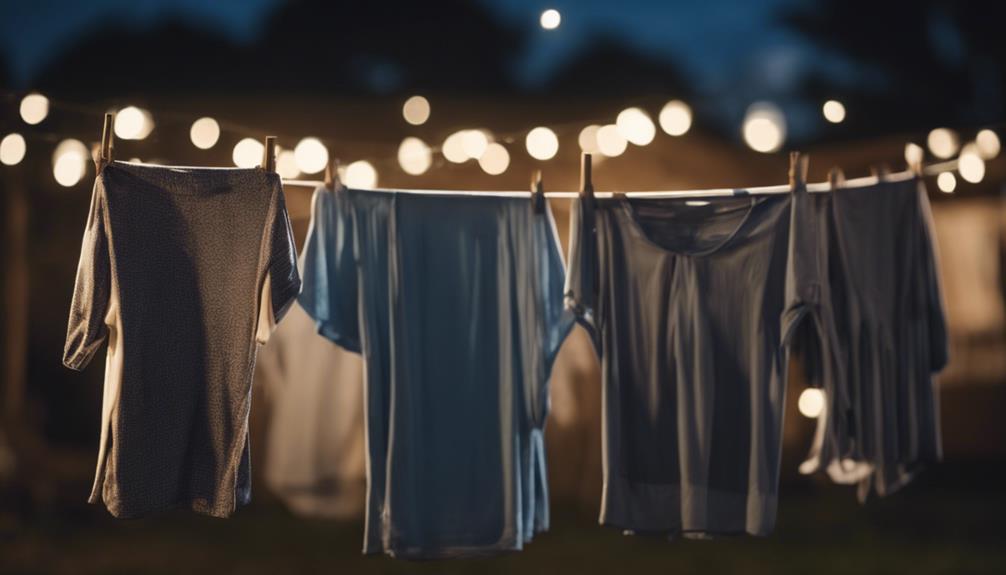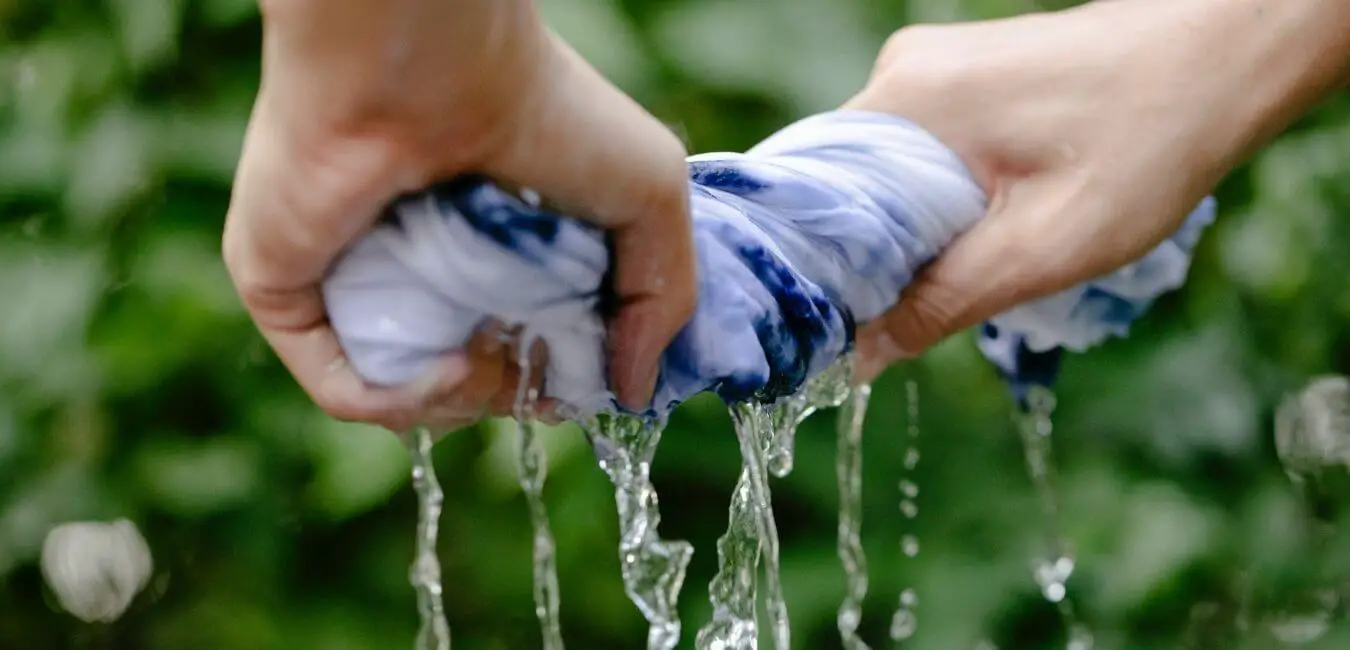When hanging clothes to dry overnight, you can optimize the drying process with some simple adjustments.
From utilizing airflow techniques to selecting the right fabrics, there are key factors to consider for efficient drying.
By making strategic changes, you can ensure your clothes are ready to wear in the morning without any dampness.
Are you ready to discover the secrets to achieving perfectly dried clothes by morning?
Benefits of Air-Drying Clothes

Save energy and protect your clothing by air-drying them overnight. It’s a sustainable choice that not only helps you cut down on energy expenses but also reduces your carbon footprint. Embrace the power of nature’s drying method instead of relying on a dryer, and you’ll be contributing to a healthier planet.
In addition to being eco-friendly, air-drying your clothes overnight gives them a natural, fresh scent that no fabric softener can match. The outdoor air leaves your clothes smelling clean and rejuvenated, creating a connection to the natural world.
Along with the delightful fragrance, hanging your clothes to dry ensures they come out free of wrinkles. Say goodbye to the hassle of ironing or using chemical-laden wrinkle release sprays – simply let your clothes hang overnight, and they’ll be ready to wear in the morning, looking neat and crisp.
Incorporate this simple change into your routine for significant benefits in terms of energy savings, environmental friendliness, refreshing scents, and wrinkle-free garments.
Proper Clothesline Setup

For efficient air-drying of your clothes overnight, a well-structured and durable clothesline setup is essential. When choosing the location for your clothesline, consider the weather conditions to optimize drying efficiency. Place the line in a spot that receives ample sunlight throughout the day and has good air circulation to aid in the drying process.
Utilize the space wisely to hang as many clothes as possible at once. Ensure the clothesline is long enough and positioned to accommodate multiple items without overcrowding.
When setting up the clothesline, take note of the wind direction. Positioning the line perpendicular to the prevailing wind allows the breeze to flow through the clothes, expediting the drying process.
Choosing the Right Location

Consider the sunlight exposure and wind flow when selecting the ideal location for your clothesline setup. For outdoor drying, seek out areas that bask in ample sunlight all day long to aid in the natural drying process. Additionally, ensure there’s good air circulation to speed up drying times.
Optimal locations may include a backyard with direct sunlight or a balcony with a constant breeze.
For indoor drying, opt for a well-ventilated space that can accommodate your clothesline comfortably. Basements or laundry rooms with windows for sunlight and airflow can serve as suitable indoor drying spots.
Keep in mind the weather conditions when deciding between indoor and outdoor drying options. Indoor drying provides protection against sudden rain or high humidity, while outdoor drying can be quicker on sunny and windy days.
Tips for Faster Drying

To expedite the drying process, maximize airflow and sunlight exposure by shaking out your clothes before hanging them overnight. Utilize these effective drying techniques and energy-saving strategies to achieve faster results. Here are some helpful hacks and methods to speed up the drying process:
| Quick Drying Methods | Energy Saving Tips |
|---|---|
| Shake out clothes before hanging | Use a fan to boost airflow |
| Hang clothes in a sunny area | Opt for a clothesline instead of a dryer |
| Use thinner hangers for better ventilation | Wash clothes in cold water to save energy |
| Space out clothes for improved airflow | Consider using a dehumidifier in the drying space |
| Choose a well-ventilated spot for drying | Try to dry clothes during daylight hours |
Best Fabrics to Air-Dry

When air-drying your clothes, it’s important to choose fabrics that dry quickly to save time and energy. Opt for materials known for their efficient drying properties. Here are some fabrics that are ideal for air-drying:
- Silk garments: Silk is a delicate fabric that dries relatively quickly when hung up to air-dry. Handle silk garments gently to maintain their luxurious feel.
- Denim jeans: Denim is a sturdy fabric that can withstand air-drying well. To prevent jeans from stiffening, reshape them while they’re drying to maintain their original fit.
- Microfiber: This synthetic fabric is lightweight and dries rapidly, making it a great choice for air-drying when you’re short on time.
- Linen: Linen is a breathable fabric that dries quickly, making it perfect for air-drying in warmer weather. Hang linen garments to dry to keep them looking crisp and fresh.
Avoiding Common Mistakes

When air-drying your clothes, it’s crucial to steer clear of common mistakes that can impede the process and impact the quality of your garments.
One prevalent misconception is that hanging clothes in a cramped space will expedite drying. In reality, providing space between items promotes better air circulation, leading to more effective drying.
To achieve optimal results, avoid overloading the drying rack or clothesline. Heavy items such as jeans or towels require sufficient space to dry thoroughly. Additionally, avoid hanging delicate fabrics in direct sunlight for prolonged periods to prevent fading or damage.
Efficient techniques include shaking out garments before hanging them to prevent wrinkles and accelerate drying. Moreover, organizing clothes based on thickness can aid in more even drying.
Remember that proper spacing and ventilation are essential to avoid issues like musty odors or prolonged drying times.
Hanging Delicate Garments
When hanging delicate garments to dry overnight, it’s crucial to consider specific fabric care tips to prevent any damage. These items require extra care to avoid stretching, snagging, or losing their shape. Proper handling techniques play a vital role in preserving the quality of delicate fabrics.
Instead of using clichés, let’s delve into the importance of handling delicate garments with care. By exploring the specific fabric care instructions for each item, you can ensure they retain their original shape and texture. Picture yourself in front of a mirror, carefully hanging these garments to dry, following the recommended guidelines.
Additionally, it’s essential to choose the right hangers or drying racks suitable for delicate fabrics. By unraveling the best practices for air-drying these items, you can maintain their quality for longer periods.
Let’s explore the impact of improper handling on delicate fabrics and how it can lead to premature wear and tear.
In order to avoid common pitfalls, let’s delve into the details of handling delicate garments with care. By delving into the fabric care labels and understanding the specific requirements of each garment, you can ensure their longevity. Picture this: a wardrobe filled with well-maintained delicate items that still look as good as new.
Fabric Care Tips
When drying delicate garments, it’s essential to handle them with care to ensure their longevity. Delicate items require special attention to protect their fabric and maintain their quality.
Here are some fabric care tips to help you preserve your delicate pieces:
- Separate Delicates: Always separate delicate garments from heavier items to prevent stretching or damage during the drying process.
- Use Gentle Detergent: Wash delicate items with a mild, gentle detergent to avoid harsh chemicals that could harm the fabric fibers.
- Avoid Direct Sunlight: Hang delicate garments in a shaded area to prevent colors from fading and fabric from weakening under direct sunlight.
- Use Padded Hangers: Opt for padded hangers to prevent delicate items from stretching or losing their shape while drying.
Taking these steps will ensure that your delicate garments stay in top condition and last for a long time.
Proper Handling Techniques
To maintain the quality of delicate garments like silk, lace, and cashmere, it’s important to handle them with care when hanging them to dry. Delicate fabrics require special attention to preserve their shape and texture. When drying these garments, consider factors like drying time and temperature control to prevent any damage or shrinkage.
It is crucial to allow delicate garments enough time to dry properly. Instead of wringing them out forcefully, gently press out excess water and then hang them up to air dry. It’s also essential to periodically check on the garments to ensure they’re drying evenly and adjust their position if necessary.
When drying delicate fabrics, be mindful of temperature control. Avoid exposing them to direct sunlight or high heat, as this can lead to color fading and fabric damage. Opt for a shaded area with good air circulation to allow the garments to dry gently and evenly.
Night-Time Drying Techniques

Let’s discuss effective methods for drying your clothes overnight.
Try out some quick nighttime drying techniques to have your laundry ready by the morning.
Follow these practical tips to ensure your clothes are dry and ready to wear in no time.
Quick Night Dry
Try out these efficient night-time drying techniques for quick results. Late-night laundry doesn’t need to be a hassle; you can take advantage of the convenience and energy savings at night with these tips.
When you wake up, your clothes will be fresh and ready to wear, saving you time and effort in the morning.
- Accelerate the drying process by placing a dehumidifier in the laundry room while you sleep.
- Opt for a high-speed spin cycle on your washing machine to remove excess water before hanging your clothes to dry.
- Enhance air circulation and speed up drying by positioning a fan near your hanging clothes.
- Hang your clothes strategically, close together but not touching, to optimize airflow and ensure even drying.
These simple steps will help you achieve a quick night dry, ensuring you wake up to freshly dried clothes and a more efficient laundry routine.
Efficient Drying Tips
To enhance the efficiency of your nighttime clothes drying routine, consider implementing these effective tips for drying garments overnight. When aiming for optimal overnight drying, it’s crucial to manage your time wisely and incorporate energy-saving strategies.
Here are some practical hacks to maximize the effectiveness of your nighttime drying routine:
Ensure Optimal Air Circulation: Hanging your clothes in a well-ventilated area or using a fan can guarantee even drying and help prevent musty smells from developing.
Utilize Quick-Drying Fabrics: Prioritize fabrics like microfiber or performance blends to speed up the drying process, especially useful for urgent needs.
Optimize Space: Maximize your drying capacity and efficiency by hanging clothes closer together without overcrowding the drying area.
Rotate Clothes Periodically: Encourage uniform drying and prevent wrinkles by checking and rearranging your clothes every few hours.
Time Your Clothes Hanging: Hang your clothes early in the evening to allow for sufficient drying time and prevent any dampness in the morning.
Maximizing Indoor Drying Space

To make the most of your indoor drying space, strategically place your drying racks or lines near a source of airflow, like a window or fan. Here are some tips to help you efficiently maximize your indoor drying space:
- Maximize Vertical Space: Opt for a collapsible drying rack that can be extended vertically to save floor space and hang clothes effectively.
- Utilize Doorways: Set up a retractable clothesline across a doorway to utilize unused space efficiently.
- Opt for Multi-Tiered Drying Racks: Choose multi-tiered drying racks to dry more clothes in a compact area without clutter.
- Rotate Clothes for Even Drying: Ensure all items receive adequate airflow by rotating them periodically on the drying racks.
Morning Care and Storage

Ensure you properly fold and store your dried garments in the morning to prevent wrinkles and maintain their freshness.
After removing your clothes from the drying rack, check for any creases that may have appeared overnight. If needed, a quick ironing session in the morning can help smooth out any folds.
To keep your clothes smelling fresh, consider using fabric softeners or lightly scented sprays before storing them. Use breathable containers or fabric bags for storage to avoid musty odors.
Hanging clothes that you won’t wear immediately can also help prevent wrinkles and keep them ready to wear. Organizing your clothes by category or color before storing will make it easier to find what you need later.
Conclusion
To sum it up, opting for air-drying your clothes overnight is a smart way to conserve energy and extend the lifespan of your garments.
By following the suggestions shared above, you can ensure that your laundry dries thoroughly and efficiently.
So, the next time you tackle your laundry, consider giving air-drying a chance – your clothes will definitely appreciate it!













